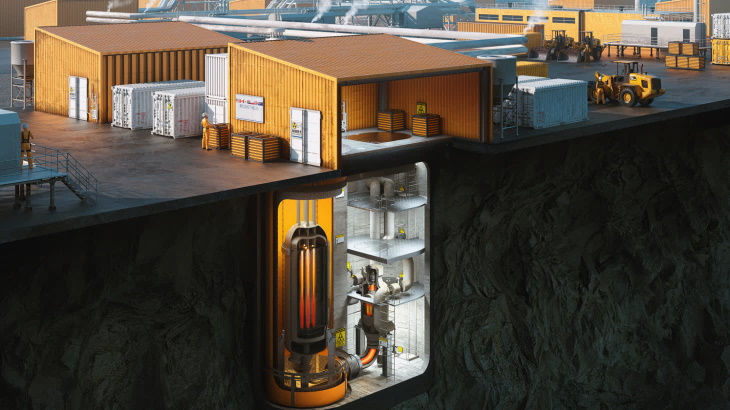There is high market potential for microreactors in US states with energy-intensive industries, nuclear-friendly laws and widespread social acceptance, according to a new report by Idaho National Laboratory (INL) examining opportunities and barriers for microreactors.

The Micro Modular Reactor design (Image: USNC)
The report - titled Microreactor Applications in US Markets - provides an evaluation of primarily state-level legal, regulatory, economic and technology implications for microreactor applications in US markets. The initial focus is on the Alaska and Wyoming energy markets serving location-specific energy needs for electricity and heat. A state-by-state evaluation of current carbon/carbon-related policies and nuclear policies is conducted to assess broader market applicability in states undergoing energy transitions.
This work is conducted as part of the Emerging Energy Markets Analysis (EMA) initiative led by INL and includes the University of Alaska, Boise State University, University of Michigan, Massachusetts Institute of Technology and the University of Wyoming.
The report summarises a US Department of Energy (DOE) Microreactor Program analysis of the market opportunities for microreactors. It evaluated several energy solutions for each profile market.
It says that favourable conditions for microreactors include, for example, markets that are cost competitive in electricity and heat, comparable (if not better) in remote locations with diesel sources, and have low-carbon sources including wind, solar, geothermal and energy storage. The use of modular designs allow transport to remote locations by road, barge or rough airstrips. Microreactors can replace coal sites using existing infrastructure. They are suited to areas where transport costs are very high and subject to access restrictions for portions of the year due to weather.
The EMA team examined the regulatory climate in each of the 50 US states in terms of openness to nuclear power, the economic assessment of heat markets that could be important to microreactor adoption, and the potential preferences for microreactor designs.
They found that most states have either removed barriers for microreactor deployment or established carbon-reduction goals that make advanced nuclear technologies attractive. However, challenges remain, such as public perceptions about microreactors' uncertainties in terms of costs, waste and fuel management.
Microreactors are suited for remote industrial applications like seafood processing in Alaska and trona mineral mining in Wyoming, the report says.
"Alaska and Wyoming have their own niche markets, but there is commonality in the remoteness of the applications, mobile uses for microreactors in mining, and energy use for refined products derived from mined sources," said David Shropshire, an INL nuclear energy economist.
The report suggests the nuclear industry and national labs increase communication about the technology and create a clear differentiation between microreactors, small modular reactors and large reactors.
It outlines areas needing further research, including developing a deeper understanding of public acceptance or resistance to microreactors. It says there is also a need to: evaluate other possible microreactor markets including conventional mining, oil and gas extraction operations, carbon refining, ammonia production, synthetic fuels, and other industries; evaluate the cross-jurisdictional regulatory considerations for land use, siting, carbon reduction, transmission corridors and mining; research the regulatory issues associated with industrial use of microreactors, and the access to and interconnection with the grid or the ability to sell excess power into deregulated markets; examine and develop business models for using microreactor heat under different scenarios; evaluate the microreactor supply chain; and evaluate considerations for siting microreactors in northern latitudes.
"Microreactors are a new technology to many of the potential deployment sites, so it is important to promote common understanding of the barriers to market entry for both developers of the technology as well as end users," said John Jackson, national technical director of the DOE Office of Nuclear Energy's Microreactor Program. "The DOE programmes support broad availability of energy solutions to meet individual needs, and characterisation of these needs is very valuable."